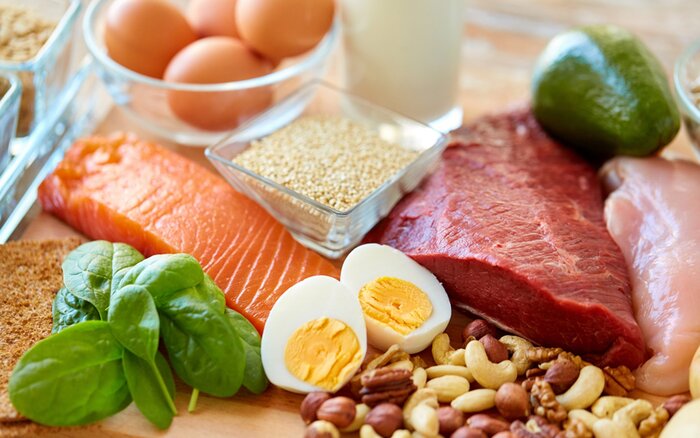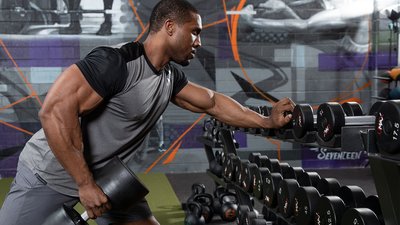How Keto Works | Keto Meal Plan | Keto for Weight Loss | Keto for Muscle Gain | Keto Mistakes & Side Effects | Best Keto Supplements
The keto diet has a wide range of associations these days—fat loss, mental clarity, health and biohacking—but building muscle isn't usually one of them. But there's merit—and research—to support the goal of building muscle on keto.
Many bodybuilders have followed something close to a ketogenic diet as part of show prep for decades. But can you build muscle on keto during a growth or maintenance phase? Yes, you can, but you'll need to be careful and intentional with every choice you make.
Ketogenesis and Protein: A Tricky Relationship
If keto bodybuilding is the goal, the first thing you'll need to modify is your "the more protein, the better" mindset. We know that getting adequate protein is crucial when it comes to building and maintain muscle mass. But that doesn't mean eating more protein will always lead to more muscle growth, especially on a ketogenic diet.
When you're on a keto diet, eating excessive amounts of protein can actually kick you out of ketosis. This is why the ketogenic diet is usually considered to be a "moderate" protein diet, not a high-protein diet.
So, what is "moderate?" As keto researcher Parker Hyde, Ph.D., explains in the article, "Ketogenic Diet: Your Complete Meal Plan and Supplement Guide," an effective ketogenic diet should include 15-20 percent of total calories from protein—and no more! This is quite low compared to the 30-40 percent of calories from protein touted by most online nutrition calculators in the bodybuilding community when you set your goal as "muscle growth."

But get this: A study published in the Journal of Sports Sciences found that consuming 0.6-0.8 grams of protein (evenly distributed between 3-4 meals while also in a calorie surplus) was adequate to optimize levels of muscle protein synthesis. This means only devoting 15-20 percent of your calories to protein is still enough to get you to that threshold.
Going any higher, like the classic 1 gram per pound of body weight, is a common keto mistake for aspiring ketogenic dieters, but don't do it! That extra protein converts into glucose, which knocks you out of ketosis. The result is you end up feeling like crap and dragging through your workouts because your body gets just enough carbs to stay carb-adapted, but without any of the fat-burning benefits true ketosis has to offer!
Stay fat-adapted with products formulated to help you maintain focus and energy while training in ketosis.
Still, it's understandable to be hesitant about potentially cutting back on protein. Here are three ways to make sure that you're getting the most out of every gram in your diet while following the ketogenic diet.
Keto Muscle-Growth Key 1: Focus on High-Quality Proteins
A high-quality protein source is one that contains all nine essential amino acids and is specifically rich in the key muscle-building amino acid leucine. Lower-quality proteins, like grains and legumes, aren't usually on the menu for the ketogenic diet anyway.
The best keto protein choices include eggs (both yolk and white), whole-fat milk, Greek yogurt, cheese, chicken, turkey, pork, beef, lamb, fish, and seafood. As much as possible, get your protein from these sources, and you'll give your body more of the amino acids it needs to preserve and add lean muscle mass.

Keto Muscle-Growth Key 2: Nail Your Protein Timing
Research in recent years shows it's not just how much protein you eat in a day that matters, but also when you eat it—or more specifically, how you space it out across the day.
To receive maximal benefit from the protein you consume, you should eat a specific amount of high-quality protein—enough to reach what is known as the "leucine threshold"—every few hours. But once you've met this threshold at a meal—which is 25-35 grams of protein per meal for most individuals—there's no added muscle-building benefit. This is especially true if it will kick you out of ketosis.
Keep it simple: Focus on eating 3-4 meals per day, each with a fairly consistent amount of protein, so that you can reach the leucine threshold at each meal. This will yield some fantastic muscle-growth results—assuming you're also training hard to stimulate that muscle growth.

Keto Muscle-Growth Key 3: Stay in a Calorie Surplus
No matter what type of diet you follow, one thing is always true: Your muscles need calories to grow! Most people use a keto diet to lose weight, but if your body composition goal is to build muscle, a calorie deficit will not help you accomplish it.

The study mentioned earlier determined that consuming moderate protein was sufficient, provided the subjects spread out their meals and ate in a caloric surplus. That last part is key! When keto gains is the goal, you need enough calories. Use Bodybuilding.com's calorie calculator to determine exactly how many calories you need each day based on your personal goals, or the macro calculator to get your standards for not only calories but also protein, carbs, and fats. You can even customize it for your ketogenic macros!
Want more info about fitness nutrition? Check out Bodybuilding.com's Foundations of Fitness Nutrition course to learn the essentials of eating right for any goal.

